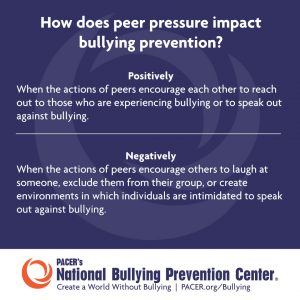In This Section
How Does Peer Pressure Impact Bullying Behavior?
Peer pressure occurs when a peer group or individual encourages others to change their attitudes, values, or behaviors to conform to those of the influencing group or individual.
Peer pressure can impact bullying behavior both in positive and negative ways. It is about feelings of fitting in with a group, whether they are friends or a group you would like to be friends with in the future. There is a positive impact when students create “feel good” moments, encouraging positive and healthy behavior, and make peers eager to join in. For example, when the peer group encourages kind and inclusive behavior, such as inviting others to join them at the lunch table or letting someone know that they care what is happening to them. The action of peers encouraging each other to reach out to those who are struggling can have a positive impact on the group and other individuals who want to speak out against bullying.
Peer pressure can also impact bullying in a negative way. If bystanders laugh when someone is being bullied, it shows support for the student bullying, not for the target. If what an individual or group is encouraging makes people feel bad, guilty, or like they are hurting other’s feelings, the behavior is most likely causing someone to feel sad and isolated.
Peer pressure is a natural part of forming friendships and maintaining groups. It has probably always been a part of society. Bullying behavior is about using one’s power over someone else in a hurtful way. Because bystander intervention is so important in helping to prevent bullying, using peer pressure in a positive and healthy way to encourage kindness, inclusion, and acceptance is one way to make a positive impact in our schools and communities.
